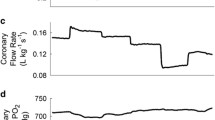Summary
In this study we investigated myocardial structural alterations and regional myocardial blood flow in chronic volume-overload induced left ventricular hypertrophy in the dog. Moderate hypertrophy (28%) was produced by inserting a shunt between the left subclavian artery and the left atrial appendage in 7 dogs (LVH), while a sham operation was performed on 5 control dogs (C). At a paced heart rate of 100 beats/min there were no differences in blood-flow distribution to the subendocardium (ENDO) mid-myocardium (MYO) or subepicardium (EPI) or in ENDO/EPI ratios between the two groups of dogs. Following adenosine-induced coronary vasodilatation (1 mg/kg/min), there was a relative shift in blood flow away from the ENDO in the LVH dogs so that the ENDO/EPI ratio was reduced. Analysis of the microvascular bed and myocyte cross-sectional area in the same three regions of interest revealed a significant reduction in capillary density in the ENDO region of the hypertrophied hearts when compared to controls (LVH=2463±10, C=2773±75 caps/mm2) and a corresponding increase in myocardial cell cross-sectional area (LVH=262±10, C=233±36 μm2). The reduction in capillary density in LVH may be explained on the basis of increased muscle growth without appropriate capillary proliferation indicating an inadequate neovascular response to this form of overload. The results also indicate that blood-flow distribution abnormalities may not be detected at resting flow with moderate LVH produced by volume overload.
Similar content being viewed by others
References
Bache JF, Cobb FR (1977) Effect of maximal coronary vasofilation on transmural myocardial perfusion during tachycardia in the awake dog. Circ Res 41:648–653
Bove AA, Hultgren PB, Ritzer TF, Carey RA (1979) Myocardial blood flow and hemodynamic responses to exercise training in dogs. J Appl Physiol 46:571–578
Breisch EA, Houser SR, Carey RA, Spann JF, Bove AA (1980) Myocardial blood flow and capillary density in chronic pressure overload of the feline left ventricle. Cardiovasc Res 14:469–475
Cobb FR, Bache JF, Geeenfield JC (1974) Regional blood flow in awake dogs. J Clin Invest 53:1618–1625
Cooper G, Puga FJ, Zujko KJ, Harrison CE, Coleman HN (1973) Normal myocardial function and energetics in volume-overloaded hypertrophy in the cat. Circ Res 32:140–148
Cooper G, Tomanek RJ, Ehrhardt JC, Marcus ML (1981) Chronic pressure overload of the cat right ventricle. Circ Res 48:488–497
Coulson RL, Yazdanfar SS, Rubio E, Bove AA, Lemole GM, Spann JF (1979) Recuperative potential of cardiac muscle following relief of pressure overload hypertrophy and right ventricular failure in the cat. Circ Res 42:41–49
Domeneck RJ, Hoffman JIE, Noble MIM, Saunders KB, Hanson JR, Subijanto S (1969) Total and regional coronary blood flow measured by radioactive microspheres in conscious and anesthetized dogs. Circ Res 25:581–596
Friedberg CK, Lasser RP, Allen DF, Furst SE, Gabor GE (1964) Production of chronic elevation of left ventricular end diastolic pressure in dogs: hemodynamic and renal studies. Circ Res 15:1–10
Holtz J, von Restorff W, Bard P, Bassenge E (1977) Transmural distribution of myocardial blood flow and of coronary reserve in canine left ventricular hypertrophy. Basic Res Cardiol 72:286–292
Hultgren PB, Bove AA (1981) Myocardial blood flow and mechanics in volume overload-induced left ventricular hypertrophy in dogs. Cardiovasc Res 15:522–528
Krahwinkel DJ, Saywer DS, Eyster GE, Bender G (1975) Cardiopulmonary effects of fentanyl-droperidol, nitrous oxide and atropine sulfate in dogs. Am J Vet Res 36:1211–1219
Lund DD, Twietmeyer TA, Schmid PG, Tomanek RJ (1979) Independent changes in cardiacmuscle fibres and connective tissue in rats with spontaneous hypertension, aortic constriction and hypoxia. Cardiovasc Res 13:39–44
Malik AB, Geha AS (1977) Cardiac function, coronary flow and MVO in hypertrophy induced by pressure and volume overloading. Cardiovasc Res 310–316
Marchetti GV, Merlo L, Noseda V, Visioli O (1973) Myocardial blood flow in experimental cardiac hypertrophy in dogs. Cardiovasc Res 7:519–527
Meerson FZ, Pshennikova MG (1965) Effects of hypertrophy on the contractile function of the heart. Bull Eksp Biol Med 59:32–35
Mueller TM, Marcus ML, Kerber RE, Young JA, Barnes RW, Abboud FM (1978) Effect of renal hypertension and left ventricular hypertrophy on the coronary circulation in dogs. Circ Res 42:543–549
O'Keefe DD, Hoffman IE, Cheitlin R, O'Neill MJ, Allard JR, Shapkin E (1978) Coronary blood flow in experimental canine left ventricular hypertrophy. Circ Res 43:3–51
Phillips SJ, Rosenberg A, Meir-Levi D, Pappas E (1979) Visualization of the coronary microvascular bed by light and scanning electron microscopy and x-ray in the mammalian heart. Scan Elec Microsc 3:735–742
Rahn H, Fenn WO (1955) A graphic analysis of the respiratory gas exchange. Amer Physiol Soc, Washington DC
Rembert JC, Boyd LM, Watkinson WP, Greenfield JC (1980) Effect of adenosine on transmural myocardial blood flow distribution in the awake dog. Am J Physiol 239:H7-H13
Ross JC (1974) Adaptions of the left ventricle in chronic volume-overload. Circ Res (suppl II) 35:64–70
Streeter DD (1979) Gross morphology and fiber geometry of the heart. In: Berne RM (ed) The handbook of physiology Sect 2 Vol 1: Williams and Wilkins, Baltimore, pp 61–112
Thomas DP, Mole PA (1981) Fluid shifts from myofibrillar to sarcoplasmic space in the myocardium of exhausted rats. Int J Sports Med 2:171–177
Tomanek RJ (1979) The role of prevention or relief of pressure overload on the myocardial cell of the spontaneously hypertensive rat. Lab Invest 40:83–91
Weibel ER (1979) Stereological methods, vol 1, Practical methods for biological morphometry. Academic Press, London
Author information
Authors and Affiliations
Additional information
Work done during tenure as a Fellow of the Southeastern Pennsylvania Heart Association
Work done during tenure as an established investigator of the American Heart Association
Supported by USPHS NIH Grants No HL 19425 and HL 07198
Rights and permissions
About this article
Cite this article
Thomas, D.P., Phillips, S.J. & Bove, A.A. Myocardial morphology and blood flow distribution in chronic volume-overload hypertrophy in dogs. Basic Res Cardiol 79, 379–388 (1984). https://doi.org/10.1007/BF01908137
Received:
Issue Date:
DOI: https://doi.org/10.1007/BF01908137




